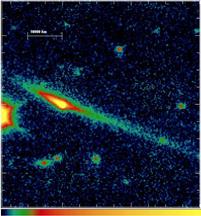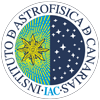
Exoplanetary Systems and Solar System
Every month a new planetary system is discovered. The Severo Ochoa project is supporting the ongoing work at IAC on the following topics related to the Exoplanetary and Solar systems research line:
1) Achieving detection of Earth-like planets around nearby stars using new more advanced ultrastable spectrographs which are under development (the IAC co-leads the instrument ESPRESSO for VLT (ESO); leads HORUS for GTC; and participates in the intrument CARMENES for 3.5m CAHA) and with high precision photometric surveys (team involved in the CoRoT space mission);
2) The characterization of exoplanet atmospheres from gas giants to exo-Earths to gain insights into their structure, surface conditions and atmospheres, culminating in evaluations on the habitability for the expected discoveries of Earth-sized planets. IAC will exploit GTC/OSIRIS exceptional tunable filter imaging capabilities complemented by unique access in Europe to instrumentation for long-coverage precision spectroscopy and photometry, through the upcoming SONG and LCOGT networks of telescopes;
3) Understanding the formation of exoplanet systems and the Earth: via detailed chemical composition studies of planet host stars;
4) Studying the physical properties of different populations and families of small bodies of the Solar System (asteroids, comets, trans-neptunian objects, etc) to obtain information of their role in its origin and evolution and how they could influence the genesis of life by bringing to the primitive Earth water and complex organics.
Goals:

- To develop spectroscopic/imaging techniques to search/detect Earth-like planets;
- Characterize exoplanet atmospheres to gain insight into their structure, surface conditions and atmospheres, including chemical composition studies which will inform on the genesis and evolution of our world and similar ones.
- Determine physical properties of small bodies of the solar system, and search for interrelations and links with their dynamical history, which will inform on the origin and evolution of our planetary system.
- Search for evidence of the presence of water-ice and complex organics in primitive objects. This will inform on the amount of water-ice and organics that incorporated the Earth due to collisions with small bodies.
- Build the flight electronics of the JEM-EUSO IRCAM mid-infrared detector and participate in future missions to primitive asteroids like NASA OSIRIS-Rex.
Main Scientific Outputs:
2012
- The empirical characterization of super-Earth atmospheres has obtained first results with GTC. The chemical composition analysis of stars harboring terrestrial planets is systematically carried out at IAC.
- Tools for detection of eclipses in light curves have been developed and applied succesfully. A laser frequency comb system has been developed in collaboration with ESO demonstrating extraordinary potential for astronomical research (published in Nature).
- IAC contributed succesfully to the final design of the optomechanics of CARMENES and of ESPRESSO, powerful instruments to search for terrestrial planets in the nearest stars.
- Tools to apply asteroid thermal models to public data from NASA WISE and derive their size, albedo and beaming parameter. Determination of the thermal properties properties of primitive B-type asteroids from WISE data (published in Astronomy & Astrophyscs)
- Study of the mechanisms that eject dust from Main Belt Comet P/2012 F5 (Gibbs) by means of visible imaging and spectroscopy using GTC (published in The Astrophyscial Journal Letters).
2013

- IAC contributed successfully to the preliminary design of the IRCAM for the JAXA JEM-EUSO mission and the phase A of THERMAP for the ESA MarcoPolo-R mission.
- Study of the mechanisms that eject dust from Main Belt Comets (300163) 2006 VW139 and P/2012 T1 (PANSTARRS) by means of visible imaging and spectroscopy using GTC (published in The Astrophysical Journal Letters).
- Visible and near-infrared observations of potentially hazardous asteroid 2012 DA14 during its closest approach of February 15th, 2013. This was the closest, predicted well in advance,recorded approach of an asteroid. Observations allowed to determine the mineralogical composition of the asteroid, similar to carbonaceous chondrites (published in Astronomy & Astrophysics).
-
The characterization of the atmosphere of the super-Earth GJ1214b has been carried out by using visual and near-infrared data from 4-m class telescopes. This study supports the evidence for a flat spectrum indicating an atmosphere with clouds and high molecular weight compositions. (accepted for publication in Astronomy & Astrophysics).
-
By a detailed and homogeneous analysis of 38 transit observations of the WASP-4b exoplanet it has been possible to improve physical parameters of the system and to model starspots. Furthermore, the timing analysis of the transits confirms a constant orbital period of this exoplanet discarding additional objects in the system, specially in Mean Motion Resonances. (published in Monthly Notices of the Royal Astronomical Society)
-
Planetary atmospheres have been studied by observing eclipses of solar system satellites produced by the shadow of their parent planets. The results have important implications for the study of transiting exoplanets atmospheres. They also provide a detailed prove of the stratosphere of the solar system planet.
-
The IAC is involved on the XO ground-based survey for Longer-Period Transiting Exoplanets.
-
Ground and space surveys for transiting exoplanets are also contributing to the field stellar oscillations. New hydro models have been developed in order to simulate the radial pulsations on the extreme Helium star V652Her using nonlinear analysis.


